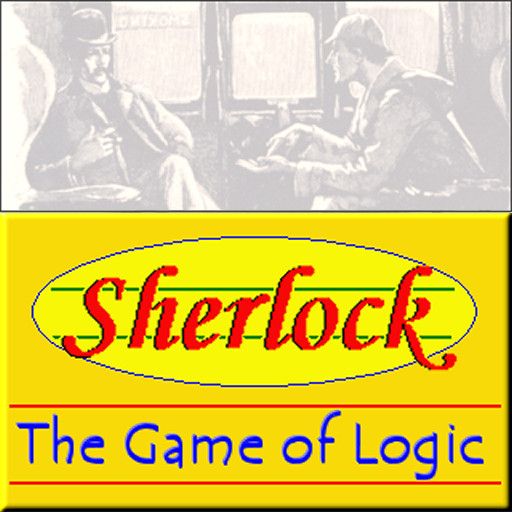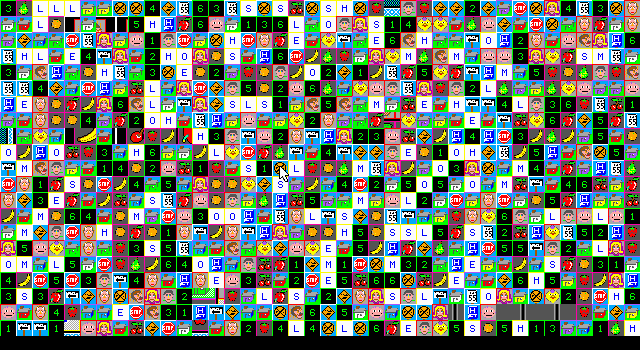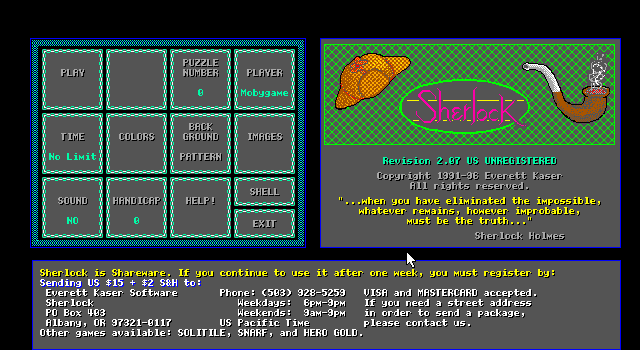Retro Replay Review
Gameplay
Sherlock places you squarely in the role of a master detective, tasked with uncovering the precise positions of 36 distinct blocks using only the clues you’re given. Each puzzle begins with a clean grid—your “crime scene”—and a set of hints designed to eliminate impossible placements until only one true arrangement remains. You’ll need to think several steps ahead, cross‐reference multiple clues, and keep track of which possibilities are still in play. The sense of accomplishment when you finally nail down a tricky block’s location makes every head‐scratcher worth the effort.
(HEY YOU!! We hope you enjoy! We try not to run ads. So basically, this is a very expensive hobby running this site. Please consider joining us for updates, forums, and more. Network w/ us to make some cash or friends while retro gaming, and you can win some free retro games for posting. Okay, carry on 👍)
The game screen is intuitively divided to keep all necessary information within easy reach. In the top‐left corner lies the puzzle solve board, where blocks are placed or ruled out. To the right, you’ll find horizontal or multi‐column clues; beneath the main grid, the vertical or single‐column clues are lined up. This spatial separation mirrors the logic you apply—using vertical hints to narrow down columns first, then shifting focus to horizontal relationships. The layout minimizes eye‐strain and helps you maintain a clear mental map of what’s possible and what’s definitively excluded.
Clue variety is where Sherlock truly shines. Vertical clues tell you whether two blocks share (or don’t share) a column, while horizontal clues come in five flavors: “is next to,” “is not next to,” “is left of,” “is between,” and “is not between.” Each type demands a different deduction strategy. For instance, “is between” clues force you to consider three‐tile chains and their mirrored possibilities, whereas “is not between” clues highlight forbidden middle positions. This range keeps puzzles fresh and compels you to adapt your approach rather than rely on rote patterns.
Graphics
Visually, Sherlock opts for a clean, minimalist aesthetic that prioritizes clarity over flash. Blocks are color‐coded and shape‐distinct, ensuring you never misinterpret your own notations. The background palette is muted, allowing the clues and grid lines to stand out sharply without creating visual fatigue during lengthy sessions. Animations are subtle—a block smoothly snaps into place, or a ruled‐out possibility fades away—reinforcing your actions without becoming distracting.
The user interface is thoughtfully designed for maximum efficiency. Clue panels use clear icons: arrows denote “left of” relationships, double‐ended arrows mark “between” clues, and simple lines indicate next‐to or not‐next‐to constraints. Tooltips hover over each icon for quick reminders. You can zoom or pan the board on larger devices, making it comfortable to play on everything from smartphones to desktop monitors. Performance is rock solid—puzzles render instantly and input is responsive, even when your deduction process involves rapid marking and unmarking of dozens of squares.
While Sherlock doesn’t aim for high‐end 3D graphics or elaborate cutscenes, its visual simplicity is actually an asset for a logic puzzle. Every pixel has a purpose: guiding your eye to relevant clues or highlighting unsolved areas. The result is a streamlined interface that fades into the background, letting your cognitive skills take center stage. In short, the graphics serve the gameplay masterfully, providing just the right balance of function and form.
Story
Although Sherlock is fundamentally a puzzle title, it wraps its logic challenges in a detective theme that evokes the spirit of Sir Arthur Conan Doyle’s iconic sleuth. There’s no sprawling narrative or voiced dialogue, but the game hints at unseen mysteries—high‐profile thefts and missing artifacts—that you’re piecing together through pure deduction. Each puzzle feels like a standalone case file, encouraging you to channel your inner Holmes as you connect the dots.
The thematic elements extend to the clue descriptions and ambient details. Subtle background art—polished oak desks, dimly lit study lamps, rolling fog beyond a windowpane—serves to immerse you in a late‐Victorian atmosphere, even if only in the margins of the main grid. Clues are phrased tersely but with just enough character to suggest you’re sifting through witness statements or guarded police reports. This lightly woven narrative context turns abstract logic into a detective exercise.
By removing a heavy story arc, Sherlock lets you set your own pace and interpret the mystery as you see fit. You might imagine each puzzle as a missing‐jewelry caper or a clandestine political intrigue—whatever fires up your imagination. The game rewards those who appreciate unadorned, pure deduction while sprinkling in just enough thematic flair to keep the experience feeling fresh and stylish.
Overall Experience
Sherlock delivers a deeply satisfying logic puzzle experience that appeals to both casual gamers and seasoned puzzle masters. Its strength lies in the elegant combination of varied clue types, intuitive UI, and a detective‐flavored presentation that never overshadows the core gameplay. Every solved grid carries a moment of triumph, as if you’d uncovered a hidden truth lurking beneath the surface of numbers and arrows.
This game is ideal for anyone seeking a mental workout—commuters looking to kill time on their phone, puzzle buffs craving fresh challenges, or board‐game fans who enjoy deduction mechanics. The absence of time limits or monetization pressures ensures that you can tackle puzzles at your own leisure. If you’ve ever found joy in logic grids, cross‐activities, or Mastermind‐style challenges, Sherlock hits the sweet spot.
No game is without its minor drawbacks. Those expecting a rich narrative or character interactions may find the story elements too sparse. After many hours, certain puzzle patterns may feel subtly repetitive, although the clue combinations are extensive. Yet these are small quibbles in an otherwise polished package. Sherlock stands out as a top‐tier logic puzzle game—elegant, challenging, and endlessly rewarding for players who relish the thrill of deduction.
 Retro Replay Retro Replay gaming reviews, news, emulation, geek stuff and more!
Retro Replay Retro Replay gaming reviews, news, emulation, geek stuff and more!









Reviews
There are no reviews yet.